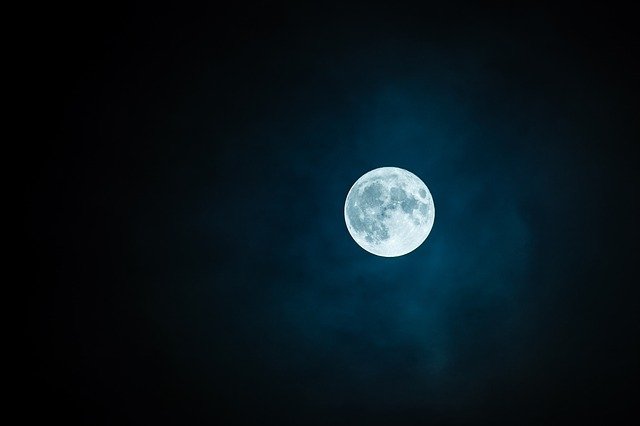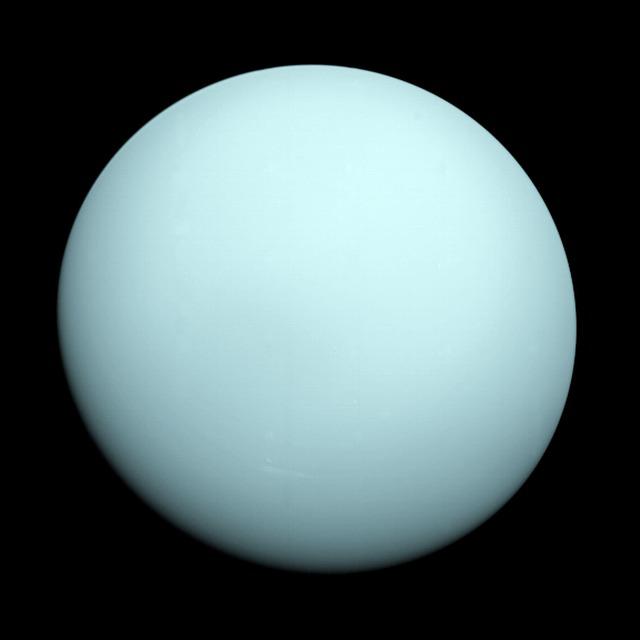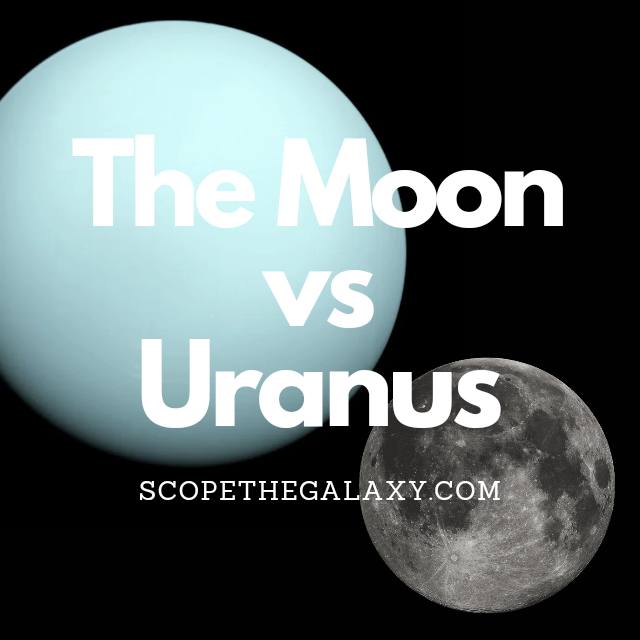*This post may contain affiliate links. This means we may make a commission if you purchase an item using one of our links*
The main differences between the Moon and Uranus is that the Moon is a rocky natural satellite that orbits Earth in an elliptical pattern and has a practically non-existent atmosphere whereas Uranus is an ice giant planet that orbits the Sun, has 27 moons with and an axial tilt of 98 degrees.
There are numerous other differences between the Moon and Uranus so continue reading if you want a more thorough look at both celestial entities as well as their similarities and differences.
What Is The Moon?
Table of Contents

The moon is the gray celestial being that orbits our Earth. It is also tidally locked to Earth meaning that we only see one side of it at any time in our sky.
It takes the moon roughly 27 days to complete an orbit around Earth, which it does in an elliptical pattern. The Moon’s axial tilt is very straight at 1.5 degrees. As a result of the tidally locked status along with the effects that Earth has on its general rotational patterns, it takes the Moon roughly 29.5 days to complete a day.
In regards to its temperature, it fluctuates where it can be really hot at 127 degrees Celsius when the Sun is shining on it and to -173 degrees in areas where the Sun does not strike it. It’s core on the other hand is far hotter ranging between 1,327 to 1,427 degrees Celsius.
This is as a result of the lunar entity’s extremely thin to practically non-existent atmosphere, which not only results in these massive temperature shifts but, is also the reason why it has over 100,000 craters on its surface.
Speaking of the Moon’s surface, the entity is mostly made of rocks, iron, magnesium just like most of the other moons and terrestrial based planets in our solar system.
It is among the bigger moons in our solar system with a diameter of 3,474.8km and a mass of 7.35 × 10^22 kg, which actually places it fifth amongst all moons in our solar system and would also make it bigger than the dwarf planet Pluto.
Despite all the advancements in technology, the last time a manned mission was made to the Moon was on the Apollo 17 way back in December 1972 and no further missions have been done since, possibly as result of the political agendas behind the numerous countries vying for opportunities that we don’t know of.
What Is The Planet Uranus?

Uranus is the 7th farthest planet from the Sun and the 3rd largest planet in our solar system, coming in at a diameter of 50,724 km. This means that roughly 63 Earth’s could fit inside this ice giant.
In regards to why this cyan blue planet is referred to as an ice giant, it’s down to it’s composition. Uranus is made mostly of methane, ammonia and water with its atmosphere mostly consisting of hydrogen and helium, much like the Sun, and the other giant planets in our solar system.
Due to its distance from the Sun, it takes Uranus 84 years to complete one orbit our central star, whereas it’s axial rotation is much faster than even our Earth at 17 hours per rotation.
As a result of its distance from the Sun, ice based composition and faster rotation levels, Uranus is far from an ideal place to live in let alone have the potential to support life.
Its base temperature is generally a chilling -190 to -200 degrees Celsius and its rocky core, although hot, is still on the cooler side for a large planet sitting around the 5,000 degrees Celsius range.
The planet’s winds are also very fast often hitting 900 km/h, which is roughly twice that of Earth’s most powerful turbulent wind speeds.
In regards to the moons surrounding this cyan planet, we’ve discovered 27 small ones orbiting it. Furthermore, it has 13 rings surrounding it which also means Uranus has the most abundant collection of rings surrounding in our solar system, which is even more than Saturn.
One of the Uranus’ most unique features would include the manner in which it rotates around its axis. As opposed to the slightly angled rotation that the likes of Earth, Saturn and most other planets display, Uranus’ axis is positioned at a 98 degree angle.
What this means is this ice giant completes an axial rotation on its side as opposed to the relatively up straight positioning of most of the other planets in our solar system.
How Is The Moon And Uranus Similar?
The Moon And Uranus don’t share too much in common as they function differently from one another but, they do have the odd few similarities, which in this case includes the below:
- Both are spherical in shape.
- Both are part of the same solar system.
- Both have a hotter central core.
Differences Between The Moon And Uranus
In regards to their differences, they include the below:
- Uranus has 27 moons whilst the Moon has no other natural satellites orbiting it.
- The Moon is tidally locked to Earth whilst Uranus is not tidally locked to any of its moons.
- Uranus has an axial tilt of 98 degrees whilst the Moon’s is practically straight at 1.5 degrees.
- Uranus is far colder than the Moon with a temperature that ranges between -190 to -200 degrees Celsius whilst the Moon fluctuates between 127 degrees Celsius and -173 degrees Celsius.
- A day on the Moon takes 29.5 days whereas a Uranus day is equal to 17 hours.
- Uranus is cyan blue in color whilst the Moon is gray.
- The Moon’s core temperature is between 1,327 and -1,427 degrees Celsius whereas Uranus’ core is 5,000 degrees Celsius.
- Uranus is far bigger than the Moon with a diameter of 50,724km compared to the Moon’s which is 3,474.8km.
- As a result Uranus is heavier with a mass of 8.681 × 10^25 kg compared to the Moon’s 7.35 × 10^22 kg
- Uranus has 13 rings surrounding it whilst the Moon has 0.
- The Moon orbits Earth in an elliptical pattern whilst Uranus orbits the Sun in a circular pattern
- Uranus is the 7th farthest planet from the Sun, which means 1 Uranus year takes 84 years whilst the Moon is joint 3rd with Earth, taking it 365 days to orbit the Sun.
Summary
Uranus is a gas based ice giant whilst the Moon is rocky natural satellite that orbits Earth. They both differ significantly whether it be in temperature, size, composition and so on.
As a result the differences clearly outweigh the similarities and Uranus is simply more influential to its surroundings than the Moon or any other natural satellite for that matter.

